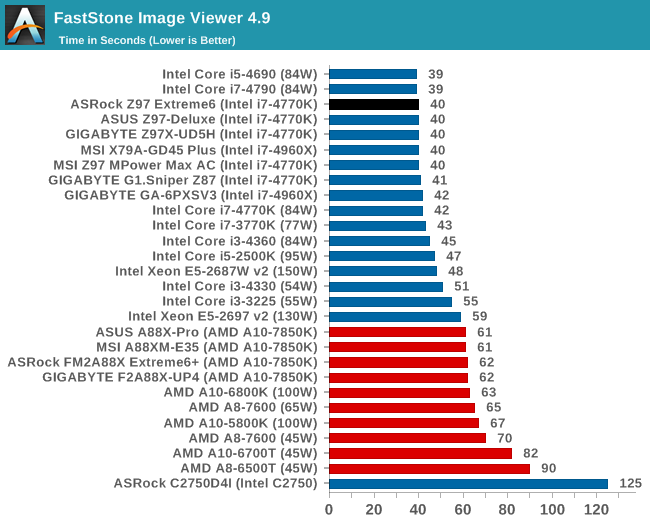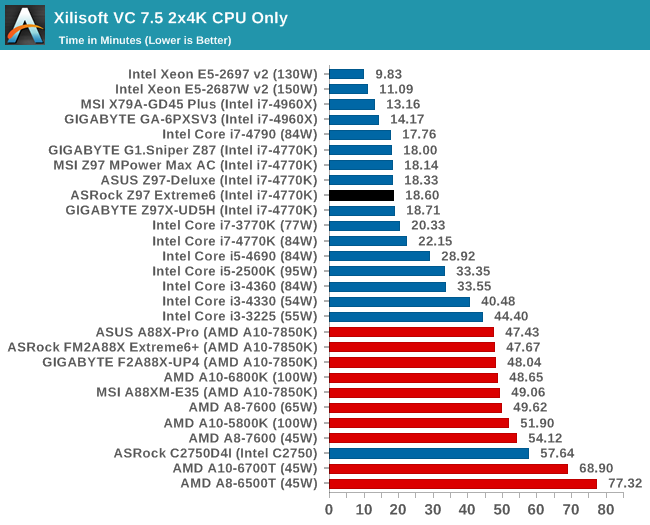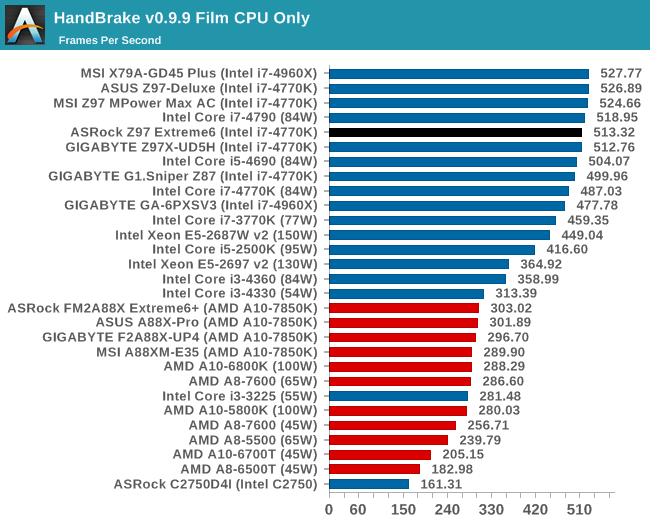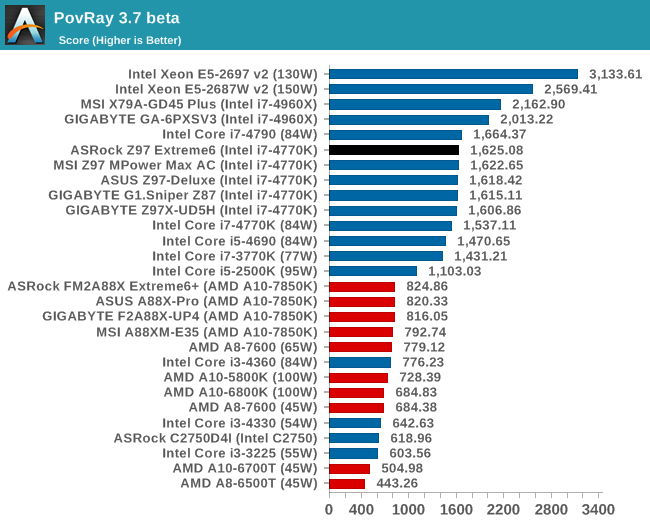ASRock Z97 Extreme6 Review: Ultra M.2 x4 Tested With XP941
by Ian Cutress on May 24, 2014 12:00 PM ESTReal World CPU Benchmarks
Readers of our motherboard review section will have noted the trend in modern motherboards to implement a form of MultiCore Enhancement / Acceleration / Turbo (read our report here) on their motherboards. This does several things – better benchmark results at stock settings (not entirely needed if overclocking is an end-user goal), at the expense of heat and temperature, but also gives in essence an automatic overclock which may be against what the user wants. Our testing methodology is ‘out-of-the-box’, with the latest public BIOS installed and XMP enabled, and thus subject to the whims of this feature. It is ultimately up to the motherboard manufacturer to take this risk – and manufacturers taking risks in the setup is something they do on every product (think C-state settings, USB priority, DPC Latency / monitoring priority, memory subtimings at JEDEC). Processor speed change is part of that risk which is clearly visible, and ultimately if no overclocking is planned, some motherboards will affect how fast that shiny new processor goes and can be an important factor in the purchase.
Compression – WinRAR 5.0.1: link
Our WinRAR test from 2013 is updated to the latest version of WinRAR at the start of 2014. We compress a set of 2867 files across 320 folders totaling 1.52 GB in size – 95% of these files are small typical website files, and the rest (90% of the size) are small 30 second 720p videos.

Image Manipulation – FastStone Image Viewer 4.9: link
Similarly to WinRAR, the FastStone test us updated for 2014 to the latest version. FastStone is the program I use to perform quick or bulk actions on images, such as resizing, adjusting for color and cropping. In our test we take a series of 170 images in various sizes and formats and convert them all into 640x480 .gif files, maintaining the aspect ratio. FastStone does not use multithreading for this test, and thus single threaded performance is often the winner.

Video Conversion – Xilisoft Video Converter 7: link
The XVC test I normally do is updated to the full version of the software, and this time a different test as well. Here we take two different videos: a double UHD (3840x4320) clip of 10 minutes and a 640x266 DVD rip of a 2h20 film and convert both to iPod suitable formats. The reasoning here is simple – when frames are small enough to fit into memory, the algorithm has more chance to apply work between threads and process the video quicker. Results shown are in seconds and time taken to encode.


Video Conversion – Handbrake v0.9.9: link
Handbrake is a media conversion tool that was initially designed to help DVD ISOs and Video CDs into more common video formats. The principle today is still the same, primarily as an output for H.264 + AAC/MP3 audio within an MKV container. In our test we use the same videos as in the Xilisoft test, and results are given in frames per second.


Rendering – PovRay 3.7: link
The Persistence of Vision RayTracer, or PovRay, is a freeware package for as the name suggests, ray tracing. It is a pure renderer, rather than modeling software, but the latest beta version contains a handy benchmark for stressing all processing threads on a platform. We have been using this test in motherboard reviews to test memory stability at various CPU speeds to good effect – if it passes the test, the IMC in the CPU is stable for a given CPU speed. As a CPU test, it runs for approximately 2-3 minutes on high end platforms.











43 Comments
View All Comments
peterfares - Saturday, May 24, 2014 - link
It was stated in the article, using 4 lanes for M.2 from the chipset would leave too little lanes left for controllers and other onboard peripheral devices.SirKnobsworth - Sunday, May 25, 2014 - link
The chipset allows up to 8 PCIe lanes. Maybe having 8 USB 3 ports and 10 SATA ports matters for some, but certainly not everyone. If you use 4 lanes for M.2 you can still have 4 additional lanes going to the NIC/x1 slots/whatever, 4 USB 3.0 ports, and 6 SATA ports, noting that FlexIO allows some flexibility in that arrangement.Galatian - Sunday, May 25, 2014 - link
This! Thousand times this! I mean at least give the option. My PC if only a gaming machine. I have one SSD inside, one mouse, one keyboard and one XBox Controller receiver. I have no need for more ports. At least give me some option: as I said it's either this extreme or the other extreme, but nothing in between.isa - Sunday, May 25, 2014 - link
But the article also said a reason was m.2 cards would mostly or only be offered in 2 channel flavors, and that makes no sense to me since I believe the z97 chipset supports 4 channels of PCIe 2.0 for m.2. I agree many would want 4 channels even if meant sacrificing a few usb ports or whatever, so I'd think the market would provide 4 channel m.2 cards to support those customers.Luke_Higdon - Sunday, April 10, 2016 - link
Question: "Can you explain to me why no mainboard manufacturer is using 4 lanes from the chipsets PCIe 2.0? I mean that would be enough for the Samsung SSD and still has room left."Answer: No It would run at a third the speed.
Question: I mean what do I gain from all those SATA and USB ports? Who is actually using all of them?
Answer: Lots of people including me. I have 6 hard drives a CD player. Plus they are very cheap to make so if you buy an upgraded motherboard this is the least they could do. I understand most people don't need all of that but that is why you would buy a cheaper Motherboard. However most people have 2 hard drives and a DVD player and it is used for adapters and if you are doing RAID it could need double the amount of SATA ports or triple.
Statement: Right now I have to choose between either a slow M.2 slot because they only allocate 2 lanes or I can go with ASRock which feels like overkill and takes away CPU PCIe lanes.
Answer: ASrock doesn't take away PCIe lanes. CPU's are given a fixed amount of PCIe lanes typically 16. If you have a video card it takes 8 and you are left with 8 in which 4 are taken from the 950 pro. If you dont play video games and use integrated graphics from a motherboard then you can buy any motherboard that uses 3.0 PCIe for at least one slot which is most of them.
Marlowe - Saturday, May 24, 2014 - link
All new motherboards should have pcie x4 m.2 slots to be worthwile.. There are really no excuse not to. The x2 version is a too small upgrade from old SATA. Anyone who buys a new fast pcie ssd will need x4 to fully utilize it.I think you can install both Win 7 and Win 8 in UEFI mode.
SirKnobsworth - Sunday, May 25, 2014 - link
A few thoughts:- The SSD only supports PCIe 2.0, not 3.0, so the maximum theoretical bandwidth is 20 rather than 32 gbps. The actual performance is still far below that too though. To my knowledge there are not PCIe SSDs currently available that support gen 3, though I think OCZ will be shipping 2.0x8 SSDs soon.
- Leaked roadmaps show that Intel will be increasing the number of PCIe lanes on the chipset rather than the processor - the chipsets accompanying Skylake should have 20 PCIe 3.0 lanes. If you want more lanes directly from the CPU then there's already an option - Intel's LGA2011 Enthusiast options have 40 PCIe 3.0 lanes from the CPU.
ShieTar - Monday, May 26, 2014 - link
Also, if the x2 port maxes out at 765 MBps of just below 6 Gbps, than we probably should not expect more than roughly 12 Gbps from the x4 port either. So the XP941 would be significantly closer to the interface maximum than the article suggests.Laststop311 - Thursday, May 29, 2014 - link
A lot of people want to build mini itx form factor. LGA 2011 doesn;t exist and never will it's physically too large a socket. All the people like me have a great need for increased pci-e lanes from the cpu. Controllers degrade performance and add latency.At the same time for mini itx you can only fit one pci-e slot on there but it would be nice if we could keep it at 16x for when gpu's do start needing the extra bandwidth and still have 8x left over for 2 4x m2 slots. 24x pci-e 3.0 cpu lanes needs to be on their mainstream. That still leaves a whole 16x gap to the enthusiast and they can increase those by 8 too to 48 lanes and keep the separation the same. Then everyone can be happy.
romrunning - Thursday, May 29, 2014 - link
I will add my vote to wanting a mini-ITX board. To me, I really don't know anyone who is actually using 3 PCIe slots. However, I do know quite a few who are tired of the big towers.Also, where are these people who want a ton of SATA slots in a home PC?? The only chassis I know where I want that many ports is in a server, and there I'm getting space for 16-24 drives - not this Frankenstein of 10 SATA slots. People at home who need a lot of space (for work or pleasure) are getting a NAS, not trying to load out a machine with 6-10 drives.
My picture of a great mini-ITX board - Z or H 9-series chipset, 4 x 6Gbps SATA ports supporting RAID 0/1/5/6, 2 x m.2 (x4) supporting RAID 0/1, no SATA Express (waste of space), 1x eSATA, 4-6 USB 3.0 ports, optional mSATA/PCIe slot for wireless add-on, and a single x16 PCIe 3.0 slot. Price it at $110-150, and I'd buy it in a heartbeat!